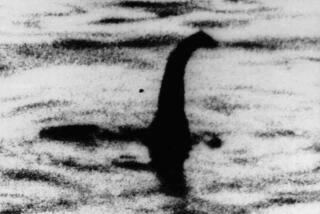Scientists to Use High-Tech Gear to Map Crater Lake
- Share via
GRANTS PASS, Ore. — Using the same deep-sea technology that treasure hunters use to find Spanish galleons, scientists plan to map Crater Lake in hopes of unlocking the secrets of the volcano that formed it.
On Monday, a boat equipped with echo-sounding equipment will start sending its pings into the cobalt-blue waters of the nation’s deepest and clearest lake, which formed from the caldera left after 12,000-foot Mt. Mazama erupted 7,700 years ago.
A team of scientists living on Wizard Island inside the caldera will send a runner up the trail from Cleetwood Cove to the rim with computer images of color topographic maps from each day’s work that will be posted on the Internet.
“It’s going to be way cool,” said Mac Brock, chief of natural resources management at Crater Lake National Park.
The $200,000 effort is the first attempt to map the lake since 1959. It is a partnership of the National Park Service, which is paying most of the bill; the U.S. Geological Survey, which is overseeing the mapping; and the University of New Hampshire, which is leasing equipment from C&C; Technologies Inc. of Lafayette, La.
The mapping will primarily focus on geothermal vents on the lake floor--1,932 feet below the surface at its deepest point--which are a factor in the lake’s chemistry and ecology. It will also try to get a better overall picture of the lake floor to help understand the volcanic eruption and formation of the lake.
“The Park Service is tasked with preserving this lake unimpaired for future generations,” Brock said. “In order to do that, we need to know as much as we can about the features, how they work, how they were formed.
“We also want to be able to tell the story. Crater Lake is a wonderful place to vacation. It is also more than that. It is a natural outdoor laboratory for world-renowned research. Knowing more about the lake bottom helps scientists worldwide know more about volcanic lakes worldwide.”
The idea came from Interior Secretary Bruce Babbitt after he visited mapping operations using the same technology on Lake Tahoe in 1998. He raised the idea with park rangers at Crater Lake.
The initial soundings of Crater Lake in the late 1800s used piano wire and a lead weight to measure depths around the lake. Then, in 1959, echo-sounding equipment measured the depth at 4,000 points around the lake. In addition to the cinder cone that forms Wizard Island, the soundings showed an underwater cone on the lake floor.
In 1988, scientists in a tiny submarine surveyed about 2% of the lake floor and discovered hydrothermal vents with bacterial mats and tiny mites living around them. The discoveries were used to fend off development of geothermal energy outside the park.
The latest mapping effort will generate data points in the tens of millions that are accurate to within 50 centimeters, said James V. Gardner, chief of Pacific sea floor mapping for USGS in Menlo Park, Calif.
Mounted in the middle of the boat, the equipment sends out pulses of sound two or three times a second, which break into 111 beams covering an arc of 160 degrees, Gardner said.
Taking account of the properties of the water and the motion of the boat, the equipment measures the time it takes for the sound to bounce back and translates that into depth. The location of the boat is plotted to within 50 centimeters by satellite navigation gear.
“The geomorphology, or physical layout of the lake, can tell scientists a lot about how the eruption took place, what was the sequence of events that happened during the eruption, how the lake filled, the formation of the mountain itself, the formation of the lake itself,” Brock said.
Maps of Crater Lake will be posted next week at the Web site https://tahoe.usgs.gov/craterlake.
More to Read
Sign up for Essential California
The most important California stories and recommendations in your inbox every morning.
You may occasionally receive promotional content from the Los Angeles Times.













